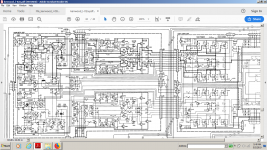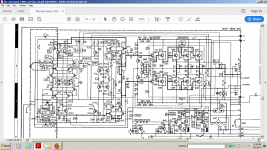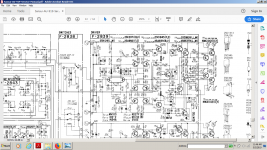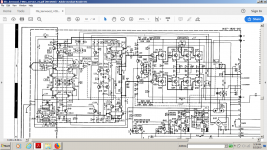No, practical. I get something new from China almost every day. Today I got a special flashlight. I also got a line voltage tester running as well.
There was a time when electronics were trusted to overcome limitations of other links in the chain like the RIAA pre emphasis for vinyls. 😉Well, yes... Layers of onion, peel away one and then deal with the next worst problem...
The digital source is hard to improve, as is the dac, amp... So - the real area to improve is speaker and room... Like JN was discussing... 🙂
As you don't like minimal designs these three are the most complicated ones that i like.They were ahead of their times and you can easily see two different approaches.
I like them also for their performance which was really high.
Unfortunately i couldn't get hold on L06m schematic...It is unobtanium.
Kenwood L-08M on thevintageknob.org
Kenwood L-02A on thevintageknob.org
Kenwood L-06M on thevintageknob.org
I don't like them because they are made by the same people that made Accuphase ,U like them for what they are.It happens that I don't like Accuphase designs at all.
I think that the Kensonic-Kenwood designs were superior, but they couldn't be rebranded after the huge insuccess they had in Germany in the 80's when they tried to sell cheap variations of the L line, while the L line was sold only in Japan and to japanese only...
If anybody would want to pay for the patents for these two amplifiers and rebuild them in a modern case they'd easily be among the best 10 high end amplifier manufacturers ever made and way over any current feedback branded design that does not get their performance.
I would build them night and day, but now we have class d which evolved a lot...so it doesn't matter if i am really fond to these designs, it wouldn't matter if the whole world would believe me when a 50 euro class d kit can sound extremely high end...and even a 2.5 dollar amp sounds better than most of the amps made in the 80's and the 90's...
The only diy design that looked interesting to me was the ZETA 2 made by Lars Clausen
https://www.diyaudio.com/forums/sol...-mosfet-amplifier-schematic-4.html#post466211
For the schematic you need to talk with him unfortunately as he deliberately deleted it from all the sites it was available.I have it and build it and it was by far the best diy design for the parts count vs performance.
Symmetrical folded cascode if anyone remembers...
He considered that class d is the future and dived into it...Today he's very successful in his business...
I like them also for their performance which was really high.
Unfortunately i couldn't get hold on L06m schematic...It is unobtanium.
Kenwood L-08M on thevintageknob.org
Kenwood L-02A on thevintageknob.org
Kenwood L-06M on thevintageknob.org
I don't like them because they are made by the same people that made Accuphase ,U like them for what they are.It happens that I don't like Accuphase designs at all.
I think that the Kensonic-Kenwood designs were superior, but they couldn't be rebranded after the huge insuccess they had in Germany in the 80's when they tried to sell cheap variations of the L line, while the L line was sold only in Japan and to japanese only...
If anybody would want to pay for the patents for these two amplifiers and rebuild them in a modern case they'd easily be among the best 10 high end amplifier manufacturers ever made and way over any current feedback branded design that does not get their performance.
I would build them night and day, but now we have class d which evolved a lot...so it doesn't matter if i am really fond to these designs, it wouldn't matter if the whole world would believe me when a 50 euro class d kit can sound extremely high end...and even a 2.5 dollar amp sounds better than most of the amps made in the 80's and the 90's...
The only diy design that looked interesting to me was the ZETA 2 made by Lars Clausen
https://www.diyaudio.com/forums/sol...-mosfet-amplifier-schematic-4.html#post466211
For the schematic you need to talk with him unfortunately as he deliberately deleted it from all the sites it was available.I have it and build it and it was by far the best diy design for the parts count vs performance.
Symmetrical folded cascode if anyone remembers...
He considered that class d is the future and dived into it...Today he's very successful in his business...
Attachments
There was plenty of 'high-end' main stream and 'boutique' gear back in the day running phenolic boards.What kind of junk still has phenolic PCBs? Certainly nothing remotely high end.
Non FG boards are still the norm for consumer gear, perhaps there is still new boutique gear retaining old sounds like phenolic paper pcbs.
Dan.
What is really funny is that all the consummer products must respect ROHS rules while most of the "high end" butique products are using lead, cadmium relays and so on...because actually they can be sourced for cheap as second hand products now and then integrated in expensive "high end" products...
There was plenty of 'high-end' main stream and 'boutique' gear back in the day running phenolic boards.
Non FG boards are still the norm for consumer gear, perhaps there is still new boutique gear retaining old sounds like phenolic paper pcbs.
Dan.
I don't think it's the norm for consumer gear any longer. You don't see many multilayer boards that aren't at least cheap FR4. I have a 20 year old Yamaha receiver with FR4, sound cards from the 90s all FR4.
Indeed, they are a nightmare for anyone who'd think to replicate them and not just because they have many parts, but also because they have the best transistors ever made like 60...80 mhz FT for the final transistors, ultra low noise bipolars and matched ultra linear fet transistors. They actually used the same fets they used in the most expensive instrumentation .Half of the components are unobtanium.
I just admire their thinking although i'd probably look at much more simple designs to build for myself.Due to the fact that they were sold only in Japan it's very hard to find them from a reliable source.
I'd be thinking of trying one of your designs or anything similar from the japanese (you know that they did lots of complementary fet designs) if finding matched complementary j-fet transistors would be easy...but unfortunately building your amps is just another case of unobtanium components.
I just admire their thinking although i'd probably look at much more simple designs to build for myself.Due to the fact that they were sold only in Japan it's very hard to find them from a reliable source.
I'd be thinking of trying one of your designs or anything similar from the japanese (you know that they did lots of complementary fet designs) if finding matched complementary j-fet transistors would be easy...but unfortunately building your amps is just another case of unobtanium components.
The recent power amp schematics that you have put up are very interesting. Thanks for putting them online.
Chinese stuff is so cheap it's malpractice NOT to try it and see what you think. There have been a few cases where I was shocked, surprised, and delighted. While spending minimal dollars. I say again, minimal.
I bought a Topping D10 DAC for 60 bucks (ESS9018 IIRC) and the internal/external build quality is superb. I think it also sounds superb for the money straight out the box.
I lived and worked in the Far East for 10 years. They may do things a bit differently, but the engineers are very good and the quality has come along in leaps and bounds.
Anyone turning their nose up at Chinese stuff is being a snob. Remember how Japan started out.
Last edited:
The conversations on this forum are very interesting.
- "I feel its warm, tonight !"
- "Proof ?"
More like:
- "I feel its warm, tonight !"
- "Feels normal to me"
- "No, my feelings are correct, yours are wrong!"
- "Proof ?"
🙂
Last edited:
Bonsai, thank you for mentioning this, couldn't agree more! China increased our purchasing power by much. We would be much poor gadged wise if it weren't for China.
<snip>
Anyone turning their nose up at Chinese stuff is being a snob. Remember how Japan started out.
Normally all started that way at one point in their history. As an example, the label "Made in Germany" was afair once invented by Britons as a mark of the inferior quality of the products.
But today we shouldn´t forget about the conditions that allow such low prices for a lot of the welcomed stuff.....
@Chris719,
<snip>
But, also it seems to be reasonable, this conclusion is a "non sequitur" as it was shown by the experiments on inattentional blindness and inattentional deafness. The given evidence leads to the conclusion that it might be often a matter of distraction; if the distraction is sufficiently strong even quite obvious things can remain undetected in a multidimensional evaluation process.
Forgot to add/edit yesterday; in the first sentence it should be "although" instead of "also" .
It all means that drawing further conclusions from test results is a complex matter if we don´t know about the conditions.
A safe conclusion is that a (perhaps existent) difference isn´t detectable under all conditions.
But without positive controls (and negative as well) an observer does not know about the detection abilities under the specific test conditions.
The recent power amp schematics that you have put up are very interesting. Thanks for putting them online.
It's not immediately obvious, but Kenwood l-08 has the same input principle as Sansui AU919. They were both based in Tokyo and maybe their engineers had a collaboration .
Now we have tpa3116d2 and that little 2.5 dollar amp is not a joke in its power range. And by the way, it might be manufactured in China, but its developed by Texas Instruments...from Texas...USA?
Attachments
Last edited:
...But today we shouldn´t forget about the conditions that allow such low prices for a lot of the welcomed stuff.....
+1k...glad to see someone here is thinking past the puerile thrill of a low price...
Howie
Normally all started that way at one point in their history. As an example, the label "Made in Germany" was afair once invented by Britons as a mark of the inferior quality of the products.
But today we shouldn´t forget about the conditions that allow such low prices for a lot of the welcomed stuff.....
That is not true. 'Made in Germany' has always had a good brand name.
Agree with you Howie, but 'we must take the world as we see it'
By making fantastic motorbikes 😉
No. With little plastic trinkets and toys etc that moved across to Hong Kong in the early 1960's already. The bikes came later - and when Triumph et al heard about it, they dismissed them. Big mistake.
I recall my father getting a 'Made in Japan' 'Silver' transistor radio in about 1962 or 63 for taking out a life insurance policy and my folks were amazed at how small it was and how good the reception was (We had a big old RCA radiogram in the living room at the time).
Yes, I think Class D is obviously the future. All about efficiency. Its consequence on batteries life, radiators and weight & size, and even ecology. Specially for smartphones + headphones and, the opposite, high power P.A. systems.He considered that class d is the future and dived into it...
But, like so many people noticed at the beginning of CD, not so good, for the moment, for treble in good Hifi Systems.
Of course, if you believe a bandwidth of 20 to 20 000 is good enough to reproduce music if distortion is low enough, you will find their characteristics satisfying up to amazing.. on the paper.
But, if you listen carefully with analytic speakers, you will feel the same type of benefits and drawbacks that lot of people were feeling at the beginning of audio CDs.
Separation is excellent, transparency is excellent. But ... Something is lost in the course. A feeling of emptiness, too clinical, and some details are like erased. We where talking about reverberation tails, as an example.
On my side, I reserve them for bass reproduction in my multiway. And I'm sure that it will improve when the switching frequency will be increased.
It seems that KEF thought the same, because they used a class D for low range and a traditional class AB to feed the tweeter of their LS50 wireless.
It is the same story than CD. When they were issued, the theory told-us that, because we are not able to listen sinusoidal signals faster than 20KHz, (and lot less for aged people), a sampling rate of 44.1KHz was enough. Even at the age of >70, I'm still able to make the difference between a HD sample and the same at 44.1.
Phase rotation effects ? Effect of remaining garbage of the switching frequency in the filtered output signal ?
May-be, may-be not.
We don't know so much about the way our highly computed hearing system works. Specially in the time domain.
PS: I was on the web site of Hypex. The kingdom of Bruno, right ? Find all the ordinary audiophile B.S about their amps. The best blabla, the most blabla. Had to search a lot to find some hidden technical DATA that need a download! And no phase or group delay response curve.
It look contradictory that, when more and more people turn in some of an excessive "objectivism", fighting against supposed audiophile illusions, the majority of constructors do exactly ... the opposite.
Last edited:
Did you listen to a properly modded Marantz cd 63 or cd67 made in 1994?
Its dac has PWM output, which is Class D.
Are you curious to see how many people consider that player one of the best player ever made?
Well we are in 2019, 25 years later!!!
And by the way, the best part of the mod is removing the HDAM fet stage...and using better op-amps after the dac, more revealing op-amps!
Its dac has PWM output, which is Class D.
Are you curious to see how many people consider that player one of the best player ever made?
Well we are in 2019, 25 years later!!!
And by the way, the best part of the mod is removing the HDAM fet stage...and using better op-amps after the dac, more revealing op-amps!
Last edited:
Yes, I had even one at home. One of the best at its time ? But, think to this, if it was fully satisfactory, I would always use it today ;-)Did you listen to a properly modded Marantz cd 63 or cd67 made in 1994?
I think you misunderstood my comments. I don't dismiss the class D, on the contrary. And , anyway, if I did, it would not matter.
If i was still in the business to day, I think i should devote myself to this technology, because, as I said, I believe it is the future. I just point what i feel the drawbacks of a tech. that is at its infancy.
In the 70, at the beginning of my career, I thought that solid state was not at the level of tube technology. Guess what ? I never designed not worked on any tube gear apart for guitar amps. ;-)
And It seems I was not so wrong: nowadays, solid state wins near all the challenges and tubes are not even manufactured on an industrial level.
By the way, what was the switching frequency of the PWM of this Marantz ?
Not to forget than comparing a line level output stage driving a kind of passive linear stage with a power amplifier that drive a Speaker is comparing apples to oranges.
Last edited:
- Status
- Not open for further replies.
- Home
- Member Areas
- The Lounge
- John Curl's Blowtorch preamplifier part III



